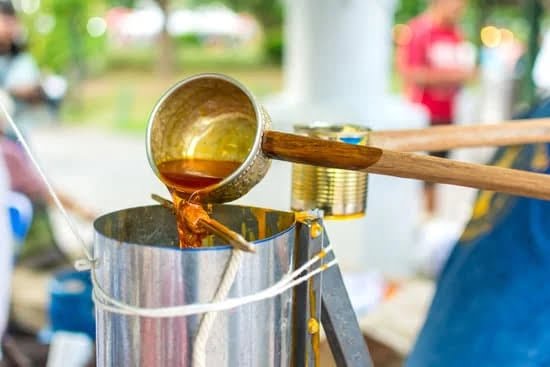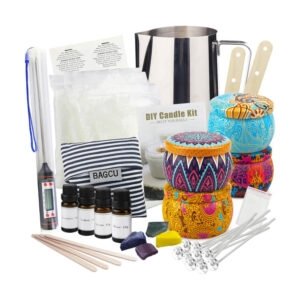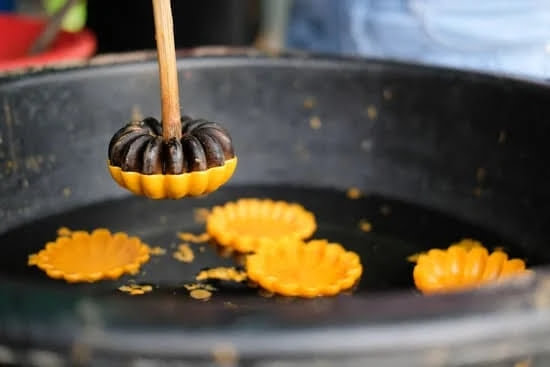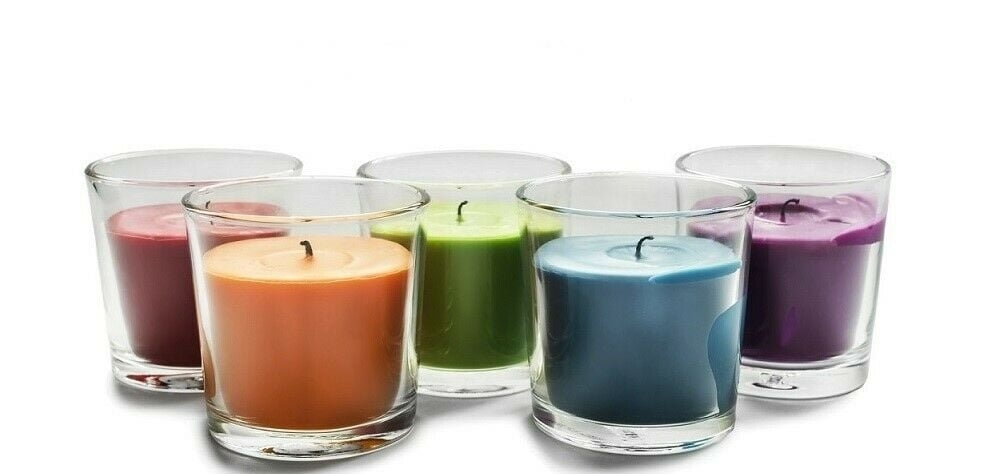Candles have long been cherished for their soothing ambiance and warm glow. From flickering candlelit dinners to moments of relaxation, candles play a significant role in creating a cozy atmosphere.
But what if you could take your candle-making hobby to the next level by adding vibrant colors that truly reflect your personal style and creativity? This article will guide you through the art of adding color to candle making, offering valuable tips and techniques to help you create unique and personalized candles.
Adding color to your candles is an essential step in the creative process, allowing you to infuse your own personality into each one. Whether you want to match a specific theme or simply add a pop of color to brighten up your space, incorporating dyes into your candle-making routine can transform ordinary candles into extraordinary works of art.
By understanding the various types of dyes available and experimenting with different techniques, you can create captivating candles that not only illuminate but also capture attention.
In this comprehensive guide, we will delve into everything you need to know about color additives for candle making. We will explore different types of dyes, such as liquid dyes, powder dyes, and dye blocks – discussing their properties, benefits, and applications. Additionally, we will share step-by-step instructions on preparing your workspace for successful dye incorporation and provide tips for choosing the right colors that complement your designs.
Now is the time to unleash your creativity and discover the exciting possibilities that come with adding color to candle making. So gather your tools and prepare to embark on a journey filled with vibrant hues, stunning patterns, and beautiful gradients. Get ready to create candles that are not only sources of light but also symbols of self-expression and personal style. Let’s dive in.
Understanding the different types of candle dyes
Adding color to candle making is an essential step in creating unique and personalized candles. By incorporating different colors, you can enhance the aesthetic appeal of your candles and create a visual experience that matches the desired ambiance. To successfully add color to your candles, it is crucial to understand the different types of candle dyes available.
One type of dye commonly used in candle making is liquid dyes. These dyes come in small bottles with droppers, allowing for easy and precise measurement. Liquid dyes offer vibrant and consistent colors, making them perfect for achieving bold and vivid candle designs. They are also easier to mix compared to other types of dyes. When using liquid dyes, it is important to follow proper measurements and mixing techniques, ensuring that you achieve the desired shade without overpowering the wax.
Another type of dye used in candle making is powder dyes. Powder dyes are highly concentrated pigment powders that can easily mix into various mediums, including candle wax. They offer a wide range of intense and rich hues that can be blended together to create custom shades. When working with powder dyes, it is important to ensure even distribution throughout the wax to prevent clumping or uneven coloring.
Dye blocks are another popular option for adding color to candles. These blocks are solid chunks of colored wax that melt when added to the hot wax during the candle-making process. Dye blocks are known for their versatility and can be used in different ways to create beautiful effects like patterns, gradients, or multicolored layers within candles. They allow for experimentation and creativity by combining multiple colors or incorporating different techniques such as layering or marbling.
Understanding the different types of candle dyes is crucial for achieving desired results when coloring your candles. Whether you opt for liquid dyes for vibrant consistency, powdered ones for intensity and customization, or dye blocks for creative effects; each type offers unique advantages in creating visually stunning candles that truly stand out. By exploring and experimenting with different types of dyes, candle makers can add their personal touch and unleash their creativity in the wonderful world of candle making.
Preparing your workspace
Preparing your workspace is an essential step in the candle making process, especially when it comes to adding color to your candles. A clean and organized workspace will ensure that you have everything you need within reach and prevent any potential mishaps or accidents. Here are step-by-step instructions on how to set up your workspace for coloring candles, including necessary tools and materials.
- Clear and clean your workspace: Start by clearing off your work area of any clutter or unnecessary items. This will give you enough space to comfortably work on coloring your candles. Wipe down the surface with a damp cloth to remove any dust or debris.
- a. Heat-resistant containers: Choose containers that can withstand high temperatures, such as glass or metal containers specifically designed for candle making.
- b. Double boiler or melting pot: This is used to melt the wax without direct heat, ensuring a safe and controlled melting process.
- c. Thermometer: It’s crucial to monitor the temperature of the wax throughout the coloring process. A candy or candle thermometer is ideal for this purpose.
- d. Stirring utensils: Use heat-resistant stirring utensils like silicone spatulas or wooden spoons to mix the dye into the melted wax.
- e. Safety gear: As always, prioritize safety when working with hot wax. Wear gloves, protective eyewear, and an apron or old clothing that you don’t mind getting stained.
- Set up your colorants: Depending on the type of dye you’re using (liquid dyes, powder dyes, or dye blocks), prepare them according to their specific instructions. Measure out the required amount of dye into separate containers if needed.
- Organize your work area: Lay out all of your tools and materials in a systematic manner so that they are easily accessible during the coloring process. Consider using small containers or trays to keep everything organized and prevent any spills.
- Ensure proper ventilation: Proper ventilation is crucial when working with dyes that release fumes or strong odors. Open windows, turn on fans, or work in a well-ventilated area to promote air circulation and minimize exposure to any potentially harmful chemicals.
2. Gather your tools and materials: To add color to your candles, you will need the following tools and materials:
By following these step-by-step instructions for preparing your workspace, you’ll be ready to start adding color to your candles with ease and efficiency. Remember, a clean and organized workspace not only ensures a smooth working process but also allows you to fully enjoy the creative and gratifying art of candle making.
Choosing the right color for your candles
When it comes to candle making, adding color is an essential step in creating candles that are unique and personalized. The right color can enhance the overall aesthetic of your candles and evoke a specific mood or ambiance. In this section, we will discuss tips and techniques for choosing the right colors for your candles.
Understanding color theory is key to selecting colors that work well together and create a harmonious design. Color theory is the study of how colors interact with each other and how they are perceived by the human eye. By understanding basic principles such as complementary colors, analogous colors, and color temperature, you can create visually appealing candles.
Complementary colors are pairs of colors that are opposite each other on the color wheel. When used together, they create a vibrant contrast. For example, yellow and purple or red and green are complementary pairs. Analogous colors are groups of three adjacent colors on the color wheel that blend well together. This creates a sense of harmony in your candle design.
Considering different color palettes is another important aspect of choosing the right colors for your candles. Different color palettes can evoke different moods or aesthetics in your candles. For example, warm tones like reds, oranges, and yellows can create a cozy and inviting atmosphere in your candles. Cool tones like blues, greens, and purples can give off a calming and soothing vibe.
| Primary Color | Complementary Color |
|---|---|
| Red | Green |
| Blue | Orange |
| Yellow | Purple |
By familiarizing yourself with color theory and considering different color palettes, you can create candles that are visually appealing and evoke the desired ambiance. Remember to experiment and have fun with colors to unleash your creativity in candle making.
Using liquid dyes
Liquid dyes are a popular choice for adding vibrant and consistent color to candles. They come in a variety of shades and can easily be mixed together to create custom colors. Here is a detailed guide on how to use liquid dyes effectively in your candle making process.
Proper measurements
When using liquid dyes, it is essential to measure the right amount for your candle wax. Too little dye may result in pale and faded colors, while too much dye can lead to an uneven burn or even cause the candle to smoke excessively. It is recommended to follow the manufacturer’s instructions for the specific brand of liquid dye you are using.
In general, a good starting point is 1 ounce of liquid dye per pound of wax. However, some dyes may require less or more depending on their concentration and the desired intensity of color.
Mixing techniques
To achieve an even distribution of color throughout your candle wax, proper mixing techniques are crucial. Here’s a step-by-step guide:
- Begin by melting your candle wax according to the instructions provided.
- Once melted, remove the wax from heat and let it cool slightly. Adding liquid dye to extremely hot wax can affect its color outcome.
- Stir the dye thoroughly before adding it to the melted wax. This ensures that any settled pigments are evenly distributed.
- Slowly pour the desired amount of liquid dye into the melted wax, stirring continuously as you do so.
- Continue stirring until you achieve a uniform color throughout the entire mixture.
- If necessary, you can add additional drops of liquid dye in small increments until you reach your desired shade.
Remember that colors may appear differently once your candle has solidified, so it’s always wise to test a small batch before committing to larger quantities.
Using liquid dyes in candle making provides flexibility and control over the final outcome of your candles. By following proper measurements and mixing techniques, you can achieve vibrant and consistent colors that enhance your candle designs.
Exploring powder dyes
Selecting the Right Powder Dye
When it comes to powder dyes, there are a wide variety of options available in terms of colors and finishes. Before starting the process, it is important to select the right powder dye that suits your candle design and desired outcome.
Consider factors such as the type of wax you are using, as some powder dyes may not work well with certain types of wax. Additionally, think about whether you want a matte or shimmering finish for your candles, as different powder dyes can give different effects.
Preparing the Dye Mixture
To ensure even distribution and prevent clumping, it is essential to prepare the powder dye mixture properly. Start by measuring out the desired amount of dye according to the instructions provided by the manufacturer. It is recommended to use a small scale or measure by weight rather than volume for more accurate results.
Next, you will need to mix the powder dye with a liquid solvent or oil to create a solution that can easily be incorporated into your melted wax. Common solvents used include isopropyl alcohol, liquid oils like mineral oil or fragrance oils, or specially formulated liquid dispersants designed for candle making. The amount of solvent required will depend on the specific powder dye being used, so refer to the manufacturer’s guidelines for proper measurements.
Incorporating Powder Dye into Melted Wax
Once your dye mixture is prepared, carefully add it to your melted wax while stirring slowly and continuously. It is important to pour in small amounts at a time and thoroughly mix before adding more to ensure an even color distribution throughout.
Keep in mind that different powders may have varying solubility rates, so it’s crucial to monitor how quickly or slowly the dye dissolves in your hot wax. If you notice any clumps forming during this process, gently break them apart with a spatula or whisk until they dissolve completely.
Throughout the coloring process, it may be necessary to periodically remove a small sample of wax from the melting pot and allow it to cool slightly. This allows you to accurately assess the color of the cooled wax and make any necessary adjustments before pouring it into your candle molds.
By following these step-by-step instructions, you can effectively incorporate powder dyes into your candle making process, achieving vibrant and consistent color results without clumping. Remember to always follow safety guidelines while working with hot wax and wear appropriate protective gear such as gloves and goggles.
Getting creative with dye blocks
Dye blocks are a popular and versatile option for adding color to candles. They are solid blocks of concentrated color that can produce vibrant and long-lasting hues in your candle designs. In this section, we will explore some innovative ways to use dye blocks to create beautiful and unique patterns, gradients, and multicolored effects in your candles.
One creative technique you can try with dye blocks is creating layered or ombré effects. To achieve this, start by melting a small amount of one colored wax using the dye block. Pour a thin layer of this colored wax into your candle mold or container and allow it to cool and solidify.
Then, melt a different colored wax using another dye block and pour another layer on top of the first layer. Repeat this process with as many layers and colors as desired to create a stunning layered effect.
Another way to get creative with dye blocks is by creating marbled effects in your candles. Start by melting your choice of base color wax without any dye added. Once melted, divide the wax into separate containers if desired, depending on how many colors you want to incorporate into the marble pattern.
Take small chunks of different colored dye blocks and drop them randomly into the melted base wax. Use a skewer or toothpick to gently swirl the colors together just enough to create a marbled effect – be careful not to overmix. Pour this marbled wax into your candle mold or container for an eye-catching marbleized design.
If you’re looking for a more dramatic effect, try using multiple colors from different dye blocks within one candle design. You can achieve this by melting each color individually and pouring them in strategic spots within your mold or container.
For example, you could pour different colors onto opposite sides of the mold at the same time or create concentric circles using multiple colors poured one after another. The key is to carefully plan where each color will go so that they blend seamlessly together when the wax solidifies.
By experimenting with these creative techniques using dye blocks, you can elevate your candle designs and create truly unique and visually stunning candles. Remember to have fun and let your imagination run wild as you explore different combinations of colors and patterns. Happy candle making.
| Technique | Description |
|---|---|
| Layered or Ombré Effects | Create a multi-layered or gradient effect by pouring different colored layers of wax using dye blocks |
| Marbled Effects | Add chunks of different colored dye blocks to melted base wax and gently swirl them together for a marbled effect |
| Multiple Colors in One Design | Melt different colors from various dye blocks and strategically pour them into the mold or container for a dramatic multicolored effect |
Avoiding common pitfalls
Over-saturating the dyes
One common mistake to avoid when adding color to your candles is over-saturating the dyes. It can be tempting to add more dye than necessary to achieve a vibrant color, but this can actually have negative effects on the quality and appearance of your candles. Over-saturation can cause the wax to become unstable and may result in uneven burning or a shortened burn time.
Additionally, it can lead to bleeding or color transfer onto surfaces when the candle is lit. To avoid over-saturating your dyes, it is important to follow recommended guidelines for dye concentration and testing small batches before making larger quantities.
Underusing dyes
On the other hand, underusing dyes can also be problematic when coloring candles. If you don’t use enough dye, you may not achieve the desired color intensity or vibrancy in your finished product. This can leave your candles looking dull or lackluster.
To prevent underusing dyes, it is crucial to carefully measure and follow recommended dosage instructions provided by the manufacturer of the dye product. It is also helpful to experiment with different ratios or concentrations of dye in small batches until you reach your desired color.
Troubleshooting uneven color distribution
Uneven color distribution is another issue that might arise when adding color to candles. This occurs when the dye does not properly disperse throughout the melted wax, leading to streaks or patches of different shades within the candle. One way to troubleshoot this problem is by ensuring thorough mixing of the dye into the melted wax.
Stirring gently and consistently for an extended period of time will help disperse the dye evenly. Alternatively, if you are using liquid dyes, you may try pre-dissolving them in a small amount of melted wax before incorporating them into a larger batch for better distribution.
Another method to achieve more even color distribution is by using dye blocks. These can be shaved or grated into the melted wax, ensuring that the dye particles are dispersed throughout. Remember to stir well to fully integrate the dye blocks into the wax. If you still experience uneven color distribution despite your efforts, it may be helpful to incorporate stirring tools that are specifically designed for candle making, such as heat-resistant spatulas or stir sticks.
By avoiding these common pitfalls and troubleshooting uneven color distribution, you can ensure that your candles turn out beautifully with consistent and vibrant colors throughout. Experimentation and practice will ultimately lead to finding the right balance of dyes for your desired results in creating unique and personalized candles.
Experimenting with natural colorants
Natural colorants can offer a unique and environmentally friendly way to add beautiful hues to your candles. By utilizing ingredients like herbs, spices, and flower petals, you can create candles with a natural aesthetic that evoke a sense of tranquility and organic beauty. In this section, we will explore the benefits and limitations of using natural colorants in candle making.
One of the primary benefits of using natural colorants is their ability to provide earthy and subtle tones that are difficult to replicate with synthetic dyes. Ingredients like turmeric or paprika can produce warm yellow or orange shades, while lavender or rose petals can infuse delicate lavender or pink hues into your candles. Natural colorants can give your candles a distinct authenticity that is often associated with handmade products.
However, it is important to note that there are limitations when working with natural colorants. The colors derived from natural ingredients tend to be more muted and may fade over time when exposed to sunlight. Additionally, achieving consistent color results can be challenging as the intensity of the colors may vary from batch to batch depending on factors such as the quality and freshness of the ingredients used.
To incorporate natural colorants into your candle making process, you can either infuse them directly into the melted wax or create infused oils beforehand for more precise coloring control. It is crucial to conduct small-scale tests before committing to larger batches to determine how the colors will appear once the wax has cooled and solidified.
Experimentation is key when working with natural colorants, as they present an opportunity for creative exploration in candle making. Whether you seek vibrant hues or prefer earthy tones, incorporating natural ingredients allows you to customize your candles in a way that reflects your personal style and love for nature’s palette.
Taking your candle making to the next level
Once you have mastered the basics of adding color to your candles, it’s time to take your candle making skills to the next level with advanced techniques and tips. These techniques will allow experienced candle makers to further refine their color work and create even more stunning and unique designs.
One advanced technique that can elevate your candles is layering colors. This involves pouring different colored layers of wax one on top of another, creating a beautiful visual effect when the candle is lit. To achieve this, start by pouring a thin layer of one color into your container and allowing it to set.
Then, pour another layer of a different color on top, making sure each layer is completely cooled before pouring the next one. Repeat this process until all desired layers are added. The result will be a visually striking candle with depth and dimension.
Another technique that can add an artistic touch to your candles is creating marbled effects. Marbling involves swirling different colors together in the wax, creating a unique pattern with swirls and veins of contrasting hues throughout the candle. To achieve this effect, melt your wax as usual and add drops of various colored dye or pigment into the melted wax.
Use a skewer or toothpick to gently swirl the colors together in the wax, creating a marbled effect. Pour the marbled wax into your container and allow it to cool for a truly eye-catching finished product.
If you want to make candles that really pop with color, consider using multiple colors in a single design. This can be achieved by either layering different colored waxes or by mixing different dyes together to create custom shades. For example, you could mix blue and yellow dyes together to create a vibrant green for an outdoors-themed candle or blend red and white for a soft pink hue perfect for Valentine’s Day candles.
By incorporating these advanced techniques into your candle making process, you will be able to create candles that are not only beautifully colored but also truly unique and captivating. Remember to experiment, have fun, and let your creativity guide you as you explore the possibilities of color in candle making.
Conclusion
In conclusion, adding color to candle making is a crucial step in creating unique and personalized candles. By understanding the different types of dyes available, preparing a well-organized workspace, and selecting the right colors for your designs, you can achieve candles that evoke the desired ambiance and stand out from the rest.
Whether you choose to use liquid dyes, powder dyes, or dye blocks, following the proper techniques for each type will ensure vibrant and consistent color distribution in your candles. Additionally, exploring alternative methods such as natural colorants can provide unique benefits and limitations to further enhance the creativity in your candle making process.
As experienced candle makers continue to refine their skills, they can take their work to the next level by experimenting with advanced techniques like layering colors, creating marbled effects, and incorporating multiple colors in a single design. These techniques allow for even more customization and artistic expression in your candle creations.
In all aspects of candle making, it is important to avoid common pitfalls such as over-saturating or underusing dyes and troubleshoot problems like uneven color distribution. By avoiding these mistakes and continuously challenging yourself to try new ideas with color in your candle making process, you can truly unleash your creativity and produce candles that are not only beautiful but also reflect your personal style.
So go ahead and let your imagination run wild. Experiment with different colors, patterns, gradients, and effects. Through creative exploration and a love for color, you can elevate your candle making hobby into an art form. The possibilities are endless when it comes to using color in candle making, so enjoy the journey of creating customized products that truly stand out.
Frequently Asked Questions
What can I use to add color to my candles?
There are several options you can use to add color to your candles. One popular choice is using liquid candle dyes, which are specifically formulated for coloring candles. These dyes come in a wide range of colors and can be easily mixed in with the melted wax to achieve your desired shade.
Another option is using candle color blocks or chips, which are concentrated blocks of color that can be shaved off and added to the wax. These blocks usually offer a more intense color payoff and are great for creating vibrant and bold colored candles. Additionally, you can also experiment with natural colorants such as dried flowers or herbs, spices like turmeric or beetroot powder, or even natural clays like French green clay or activated charcoal.
Can I add food coloring to candle wax?
Yes, it is possible to add food coloring to candle wax; however, it may not be the most ideal choice. Food coloring is typically water-based, and since oil and water don’t mix well, it may cause issues with the texture and appearance of your candles. Using food coloring could result in uneven color distribution, streaks in the wax, or even separation of the dye from the melted wax.
It’s generally recommended to use specially made candle dyes that are oil-soluble for better results. These dyes are designed to blend seamlessly with the wax without impacting its performance or consistency.
How do you add natural color to candles?
Adding natural color to candles can be done in various ways using organic materials found in nature. One method involves incorporating dried botanicals into the candle wax itself. For example, you can infuse the wax with dried lavender buds for a soft purple hue or crushed petals from roses for a delicate pink tone.
Another option is extracting pigments from natural sources like fruits and vegetables by soaking them in rubbing alcohol and then straining out any solid particles before adding this solution to your melted wax. This method allows you to create custom colors using ingredients like blueberries for blue shades or spinach for green tones. Additionally, you can also explore using natural colorants such as ground spices (e.g., cinnamon, paprika), teas, or even herbal powders like spirulina or henna to impart unique hues to your candles.

Welcome to my candle making blog! In this blog, I will be sharing my tips and tricks for making candles. I will also be sharing some of my favorite recipes.





